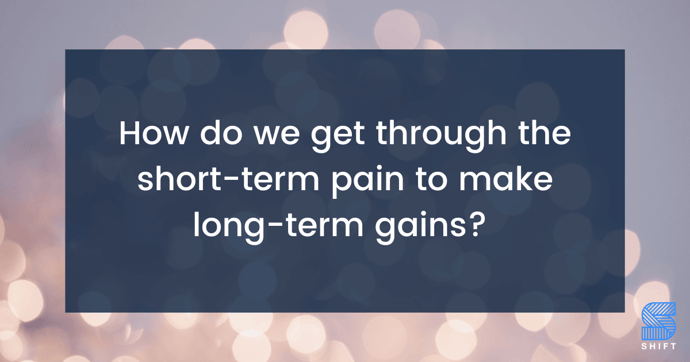
During the first 84 days of this year, I have spoken to countless CEOs about what’s keeping them up at night and what's getting them out of bed in the morning.
And the difference is stark.
What’s keeping them up at night is the angst of the future, the agony of tough decisions, and the anguish of the pace and pain of change in their teams.
In fact, one CEO said to me just last week, “This is the hardest moment of my professional career. I don’t feel like the team is giving their all or moving fast enough, and I feel like one of my executives of 10 years isn’t going to make the cut.”
All of this is hard short-term pain.
What’s getting them out of bed in the morning is the possibility and opportunity that sits in front of them. The idea that there is privilege in the pressure of having the chance to lead a group of remarkable humans.
All of this is long-term gain.

In order to thrive during times of change and uncertainty, the first step is to discern the opportunities to be seized and the temptations to be resisted.
In short, we can’t fight the wave of reality, but ride it.

If I could bottle up 22 years of talking with literally thousands of executives and entrepreneurs at the top of organizations employing 10 people to 10,000, one thing is clear – it’s lonely at the top.
It’s a unique experience as a human being.
The upside of opportunity and the downside of risk is commensurate.
It’s loud. It’s noisy. It’s a roller coaster.
I get it… these are first-world problems, but stress and pain are relative.
Most executives live by the credo that failure isn’t an option, but they know they'll make a mistake or two along the way. As Rocky said, it’s not how many times you get knocked down, but how many times you get back up.
Most CEOs are ready to sign up for this for themselves, but where most are struggling is with their team’s ability to grow regardless.
Let’s get real and raw and speak to the most relevant confessions of today’s CEOs who might be experiencing something you are living through right now. We’ll see if it sparks a way out of these double binds and rock-and-hard-place moments.
CEO Confession #1: My team is not giving their all.

Microsoft has been collecting mountains of data throughout the pandemic, and one data set that sticks out to me the most is called “productivity paranoia.”
It’s simple. When asked, only 12% of executives feel their teams are productive right now whereas 86% of employees feel they are productive.
Watching Elon go full Elon at Twitter inspired many tech firms to continue cutting, removing the bloat brought on by a hiring surge during the pandemic to revert back to the mean.
Twitter went from 7,000 full-time employees down to nearly 2,000 – and the platform still works.
Most CEOs I talk to would love to figure out if their team can do more with less, but they know opening this can of worms destroys trust.
And look, this is a feeling, not always a fact.
You are not walking the halls in the same way to feel the buzz of productivity.
As I have said in the past, the pandemic can be a great accelerant but can also be a revelation about what was always right in front of us.
You are not Elon who makes these moves from a different perch, but I do think you can do this:
Show your work. Focus on leading by example – not just in the output, responsibility, and accountability, but understanding that the role of a CEO has changed. It’s not enough to be the Chief Executive Officer. You have to be the Chief Engagement Officer.
Reset the clock. If you are leading a hybrid team, establishing a new set of norms for your digital culture can be a game-changer. Check out our Q1 SHIFT Summit where we stepped through how to create a digital manifesto.
Be curious and question everything. Ask questions like, “what if we had to double output, without hiring anyone, how might we go about it?” You can even use this opportunity to start thinking about how professional development and augmenting each of our capabilities using AI can create higher outputs of yield.
CEO Confession #2: My team isn’t moving fast enough.

I have written about this before in – What's moving faster?
TL;DR – Working with a remote or hybrid team, there are times when it feels like everything takes longer.
It’s not just that teams aren’t moving fast enough. It’s that the general resistance to change is always present.
Remember humans tend to not move faster than the pain of staying the same.
According to the management guru, John Kotler, 70% of change programs fail because of a lack of urgency, of bringing the outside in, or of telling a story.
Bring death in. My good friend Dan Engle says that nothing brings us current like death. If you knew you had six months to live, how would you spend today? What if you only had six days? See the difference? You can also do a fun exercise where you have everyone write a letter to their 90-year-old self. Check out mine.
Bring in the future vision. If I had a dollar for every employee survey we’ve done and the net feeling is people don’t know where the organization is going… Instead of coming up with short statements like, We are going to be the intelligence of all computers (the old Microsoft vision), write what Cameron Herold calls a Vivid Vision. Check out SHIFT’s 2050 vision for an example.
Bring the outside in. I love using iconic figures and unknown parts of their story. One of my favorite go-to's is the story of Martin Luther King’s letter he pinned inside the jail of an Alabama jail. Are you a thermometer or a thermostat?
The bottom line? Remember change isn’t intellectual, but emotional. Stories are one of the earliest forms of technology humans created, dating back to 30,000 years ago.
Speak from and to the heart… it rarely disappoints.
CEO Confession #3: My team is doing their best, but sometimes their best isn’t good enough.
This one is the hardest for most good and caring CEOs; the idea of how to right size the idea of loyalty and performance.
On one hand, most CEOs don’t want to let someone who is willing to try and do whatever it takes for the company to succeed go.
On the other hand, not all turtles make it to shore.

There are no easy answers here, but for this one, I am going to call in my hall-of-fame high school football coach, Roger Wrenn.
He would always say, ”I love my son, but he's not playing quarterback for me on Saturday.”
It sounds harsh, but it’s understanding the strengths, weaknesses, and potential of your team.
Beyond my coach, the Netflix documentary, Stutz, nails this. Pain, Uncertainty, and Constant Work is a given. The only thing we can do is accept this truth and change our perspective and attitude.
As Neiczhe said, “The only way out is through.”
And finally, we all know this to be true… hard choices lead to an easy life, but easy choices lead to a hard life.
Avoiding the conversation, not confronting it, isn’t helping anyone.
The Peter Principle is real. Sometimes we promote people until they are in a position they can no longer thrive in, and the idea of being relegated to a lower level of responsibility is sometimes worse than being fired.
What keeps CEOs up at night looks like angst of the future and change, but it’s really deep caring and concern for the organization you are building and those you employ to advance this vision.
The possibility and hope you feel in the morning is the clarity you need on the path forward.
You got this.







